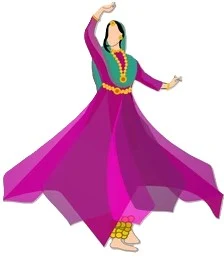Kathak Dance Which State
Kathak was made in Northern Indian regions as a classic way of dancing, more specifically linked with Uttar Pradesh. It is distinguished by its complicated foot movements, meaningful hand movements, and elaborate story-telling that often represents scenes from Hindu epics and mythology. With time though.
The History Of Kathak Dance.
Kathak is among the eight Indian classical dances. This dance has been around for centuries and has evolved over several years. Its roots can be traced back to Uttar Pradesh state in North India. Kathak’s development came about as a result of different societal situations and varied influences throughout time.
Ancient Origins
Vedic Era:
It is believed that Kathak originated from the ancient Indian tradition of storytelling. The name Kathak’ has been taken from ‘Katha’ (stories) and ‘Kathakar’ (one who tells a story). Wandering minstrels called Kathakas used to narrate myths and moral stories by using dance and music in temple environments.
During The Medieval Period:
Kathak underwent important changes in the Bhakti movement from the 8th to 16th century and was mainly associated with devotional songs and dances that were performed in the temples to tell the stories of Hindu gods and goddesses mostly Krishna and Radha. In this era, the focus was mostly on religious and spiritual matters in Kathak.
Colonial Period British Rule:
Kathak, a classical Indian dance form faced neglect and decline as other art forms because of British colonial administration. This genre existed thanks to some devoted individuals from certain families. Its purity was partially compromised since people associated it mostly with courtesans.
Post-Independence Revival:
Resurgence following independence In the 20th Century era Post-Independence period, since India became independent in 1947. There has been a revival of attraction towards classical arts with Kathak being of major concern. The Kathak Kendra which is located in New Delhi has since been set up as an institution to popularize and safeguard this dance genre. Kathak was rediscovered and introduced to the world stage by groundbreaker artists like Pandit Birju Maharaj as well as Shambhu Maharaj besides Sitara Devi.
Contemporary Kathak:
Still a classical dance, Kathak has evolved in contemporary times. Kathak is still performed in countries across the world and has absorbed fresh ideas and movements. New dance choreographies as well as fusion styles are being pursued by the present-day. Kathak performers by mixing the traditional Kathak dance with other moves.
"Important Aspects of Kathak Footwork:
- Footwork: Kathak is renowned for its complicated and rhythmic footwork, also known as tatkar. In many cases accompanied by ankle bells (ghungroos).
- Hand Gestures: They portray different emotions and stories using expressive hand gestures called mudras.
- Spins: What distinguishes Kathak from other dances are swift and elegant spins referred to as chakkars.
- Expressions: For narratives, facial expressions or abhinaya are key."
- Traditional Costumes and Classical Music: Kathak performances involve traditional costumes and classical music, often with tabla and harmonium.
Benefits of Kathak
Physical Fitness:
- Kathak helps in keeping the heart rate normal. Practicing regularly will help in increasing strength and making one strong.
- The adaptability and enduring appeal of Kathak are well illustrated by its journey from ancient temple rituals to the modern-day stages.
- With its grace and complexity as well as profound storytelling, it remains a source of inspiration for many people.
Mental Health:
- Stress Relief: Syncing to tunes involves dancing, and it has stress-reducing effects as well as lessening anxiety.
- Cognitive Skills: A better memory and functioning of the brain get improved by memorizing sequences, rhythms, and expressions.
- Focus and Discipline: One needs to be focused and disciplined when they learn how to dance Kathak, hence it helps increase their concentration level on other aspects of life.
Social Interaction:
- Community Building: Not only do the Kathak classes and performances help dancers feel that they belong or are part of some group, but they also help them become friends so that they can relate well within it.
- Networking: Introduces like-minded individuals who may attend different activities together."
Appreciation for beauty:
- Artistic talents: Mastery of Kathak enriches insights into music, rhythm, and dance as forms of art. Imagination: Kathak’s impromptu nature fosters invention and originality.
Frequently Ask Questions
Which state is connected to the Kathak dance?
Primarily, Kathak dance comes to mind when Northeastern India is mentioned but as a whole, it is associated with Uttar Pradesh; this is where it was first born and adapted before spreading all over the country.
How did the Kathak dance come into being?
Kathak is believed to be derived from story-telling done by nomadic cast in India. This was the way they could speak to their society about myths and morality only through singing, acting, and playing instruments.
In what respects does Kathak benefit the cultural heritage of Uttar Pradesh?
In other words, it is a form of dance that has been practiced for generations in Uttar Pradesh and reflects various historical and artistic influences from the region. This dance style plays a major role during festivals and other cultural events, as well as in educational institutions whose focus is on classical Indian dance and where they are being preserved as part of their heritage.
Post-independence, who were the key players in reviving Kathak?
Pioneering artists such as Pandit Birju Maharaj, Shambhu Maharaj, and Sitara Devi are credited with revitalizing Kathak following India's independence where respectively. This is because they have worked towards achieving this goal at a national level as well as globally.
How do people perform the Kathak dance these days?
In the contemporary world, the dance style of Kathak is seen in every corner of the world and has been improved while it remains firm on its traditional basis. Contemporary Kathak dancers have started experimenting with contemporary themes by fusing traditional Kathak genres with modern ones including various forms of dance.

Comments
Post a Comment